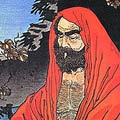 Bodhidharma was a Buddhist monk who lived during the 5th/6th century CE. He is traditionally credited as the transmitter of Ch’an (Sanskrit: Dhyāna, Japanese: Zen) to China, and regarded as the first Chinese patriarch. According to Chinese legend, he also began the physical training of the Shaolin monks that led to the creation of Shaolinquan.Little contemporary biographical information on Bodhidharma is extant, and subsequent accounts became layered with legend. There are three principal sources for Bodhidharma’s biography: Yáng Xuànzhī’s (Yang Hsüan-chih) The Record of the Buddhist Monasteries of Luoyang (547), Tánlín’s preface to the Two Entrances and Four Acts (6th century CE), and Dàoxuān’s (Tao-hsuan) Further Biographies of Eminent Monks (7th century CE).These sources vary on their account of Bodhidharma being either “from Persia” (547 CE), “a Brahman monk from South India” (645 CE), “the third son of a Brahman king of South India” (ca. 715 CE). Some traditions specifically describe Bodhidharma to be the third son of a Tamil Pallava king from Kanchipuram.
Bodhidharma was a Buddhist monk who lived during the 5th/6th century CE. He is traditionally credited as the transmitter of Ch’an (Sanskrit: Dhyāna, Japanese: Zen) to China, and regarded as the first Chinese patriarch. According to Chinese legend, he also began the physical training of the Shaolin monks that led to the creation of Shaolinquan.Little contemporary biographical information on Bodhidharma is extant, and subsequent accounts became layered with legend. There are three principal sources for Bodhidharma’s biography: Yáng Xuànzhī’s (Yang Hsüan-chih) The Record of the Buddhist Monasteries of Luoyang (547), Tánlín’s preface to the Two Entrances and Four Acts (6th century CE), and Dàoxuān’s (Tao-hsuan) Further Biographies of Eminent Monks (7th century CE).These sources vary on their account of Bodhidharma being either “from Persia” (547 CE), “a Brahman monk from South India” (645 CE), “the third son of a Brahman king of South India” (ca. 715 CE). Some traditions specifically describe Bodhidharma to be the third son of a Tamil Pallava king from Kanchipuram.
The accounts also differ on the date of his arrival, with one early account claiming that he arrived during the Liú Sòng Dynasty (420–479) and later accounts dating his arrival to the Liáng Dynasty (502–557). Bodhidharma was primarily active in the lands of the Northern Wèi Dynasty (386–534). Modern scholarship dates him to about the early 5th century.
Several stories about Bodhidharma have become popular legends, which are still being used in the Ch’an and Zen-tradition.
Bodhidharma’s teachings and practice centered on meditation and the Lankavatara Sutra.
The Anthology of the Patriarchal Hall (952) identifies Bodhidharma as the 28th Patriarch of Buddhism in an uninterrupted line that extends all the way back to the Buddha himself.
Throughout Buddhist art, Bodhidharma is depicted as a rather ill-tempered, profusely bearded and wide-eyed barbarian. He is described as “The Blue-Eyed Barbarian” in Chinese texts
Contemporary accounts
There are two known extant accounts written by contemporaries of Bodhidharma.
Yáng Xuànzhī (Yang Hsüan-chih) – The Record of the Buddhist Monasteries of Luoyang
The earliest text mentioned Bodhidharma is The Record of the Buddhist Monasteries of Luoyang (洛陽伽藍記 Luòyáng Qiélánjì) which is compiled in 547 by Yáng Xuànzhī (Yang-Hsuan-chih 楊衒之), a writer and translator of Mahāyāna Buddhist texts into the Chinese language. Yang gave the following account:
[quote_box_center]”At that time there was a monk of the Western Region named Bodhidharma, a Persian Central Asian. He traveled from the wild borderlands to China. Seeing the golden disks [on the pole on top of Yǒngníng’s stupa] reflecting in the sun, the rays of light illuminating the surface of the clouds, the jewel-bells on the stupa blowing in the wind, the echoes reverberating beyond the heavens, he sang its praises. He exclaimed: “Truly this is the work of spirits.” He said: “I am 150 years old, and I have passed through numerous countries. There is virtually no country I have not visited. Even the distant Buddha-realms lack this.” He chanted homage and placed his palms together in salutation for days on end.”[/quote_box_center]
T’an-lín’s preface to the Two Entrances and Four Acts
The second account was written by T’an-lín (曇林; 506–574). T’an-lín’s brief biography of the “Dharma Master” is found in his preface to the Two Entrances and Four Acts, a text traditionally attributed to Bodhidharma, and the first text to identify Bodhidharma as South Indian:
[quote_box_center]”The Dharma Master was a South Indian of the Western Region. He was the third son of a great Indian king. His ambition lay in the Mahayana path, and so he put aside his white layman’s robe for the black robe of a monk […] Lamenting the decline of the true teaching in the outlands, he subsequently crossed distant mountains and seas, traveling about propagating the teaching in Han and Wei.”[/quote_box_center]
T’an-lín’s account was the first to mention that Bodhidharma attracted disciples, specifically mentioning Dàoyù (道育) and Huìkě (慧可), the latter of whom would later figure very prominently in the Bodhidharma literature. T’an-lín has traditionally been considered a disciple of Bodhidharma, but it is more likely that he was a student of Huìkě.
Later accounts
Dàoxuān (Tao-hsuan) – Further Biographies of Eminent Monks
In the 7th-century historical work Further Biographies of Eminent Monks (續高僧傳 Xù gāosēng zhuàn), Dàoxuān (道宣; 596-667) possibly drew on Tanlin’s preface as a basic source, but made several significant additions:
- Firstly, Dàoxuān adds more detail concerning Bodhidharma’s origins, writing that he was of “South Indian Brahman stock” (南天竺婆羅門種 nán tiānzhú póluómén zhŏng).
- Secondly, more detail is provided concerning Bodhidharma’s journeys. Tanlin’s original is imprecise about Bodhidharma’s travels, saying only that he “crossed distant mountains and seas” before arriving in Wei. Dàoxuān’s account, however, implies “a specific itinerary”: “He first arrived at Nan-yüeh during the Sung period. From there he turned north and came to the Kingdom of Wei”. This implies that Bodhidharma had travelled to China by sea, and that he had crossed over the Yangtze River.
- Thirdly, Dàoxuān suggests a date for Bodhidharma’s arrival in China. He writes that Bodhidharma makes landfall in the time of the Song, thus making his arrival no later than the time of the Song’s fall to the Southern Qi Dynasty in 479.
- Finally, Dàoxuān provides information concerning Bodhidharma’s death. Bodhidharma, he writes, died at the banks of the Luo River, where he was interred by his disciple Huike, possibly in a cave. According to Dàoxuān’s chronology, Bodhidharma’s death must have occurred prior to 534, the date of the Northern Wei Dynasty’s fall, because Huike subsequently leaves Luoyang for Ye. Furthermore, citing the shore of the Luo River as the place of death might possibly suggest that Bodhidharma died in the mass executions at Heyin 河陰 in 528. Supporting this possibility is a report in the Taishō shinshū daizōkyō stating that a Buddhist monk was among the victims at Héyīn.
Anthology of the Patriarchal Hall

This Japanese scroll
calligraphy of
Bodhidharma reads
“Zen points directly to the
human heart, see into your
nature and become Buddha”.
It was created by
Hakuin Ekaku (1685 to 1768)
In the Anthology of the Patriarchal Hall (祖堂集 Zǔtángjí) of 952, the elements of the traditional Bodhidharma story are in place. Bodhidharma is said to have been a disciple of Prajñātāra, thus establishing the latter as the 27th patriarch in India. After a three-year journey, Bodhidharma reaches China in 527 during the Liang Dynasty (as opposed to the Song period of the 5th century, as in Dàoxuān). The Anthology of the Patriarchal Hall includes Bodhidharma’s encounter with Emperor Wu, which was first recorded around 758 in the appendix to a text by Shen-hui (神會), a disciple of Huineng.
Finally, as opposed to Daoxuan’s figure of “over 150 years,” the Anthology of the Patriarchal Hall states that Bodhidharma died at the age of 150. He was then buried on Mount Xiong’er (熊耳山 Xióngĕr Shān) to the west of Luoyang. However, three years after the burial, in the Pamir Mountains, Sòngyún (宋雲)—an official of one of the later Wei kingdoms—encountered Bodhidharma, who claimed to be returning to India and was carrying a single sandal. Bodhidharma predicted the death of Songyun’s ruler, a prediction which was borne out upon the latter’s return. Bodhidharma’s tomb was then opened, and only a single sandal was found inside.
Insofar as, according to the Anthology of the Patriarchal Hall, Bodhidharma left the Liang court in 527 and relocated to Mount Song near Luoyang and the Shaolin Monastery, where he “faced a wall for nine years, not speaking for the entire time”, his date of death can have been no earlier than 536. Moreover, his encounter with the Wei official indicates a date of death no later than 554, three years before the fall of the last Wei kingdom.
Dàoyuán – Transmission of the Lamp
Subsequent to the Anthology of the Patriarchal Hall, the only dated addition to the biography of Bodhidharma is in the Jingde Records of the Transmission of the Lamp (景德傳燈錄 Jĭngdé chuándēng lù, published 1004 CE), by Dàoyuán (道原), in which it is stated that Bodhidharma’s original name had been Bodhitāra but was changed by his master Prajñātāra. The same account is given by the Japanese master Keizan’s 13th century work of the same title.
Legends about Bodhidharma
Several stories about Bodhidharma have become popular legends, which are still being used in the Ch’an and Zen-tradition.
Encounter with Emperor Xiāo Yǎn 蕭衍
The Anthology of the Patriarchal Hall tells us that in 527 during the Liang Dynasty, Bodhidharma, the first Patriarch of Chán, visited the Emperor Wu (Emperor Xiāo Yǎn 蕭衍 (posthumous name Wǔdì 武帝) of Liáng 梁 China), a fervent patron of Buddhism:
[quote_box_center]Emperor Wu: “How much karmic merit have I earned for ordaining Buddhist monks, building monasteries, having sutras copied, and commissioning Buddha images?”
Bodhidharma: “None. Good deeds done with worldly intent bring good karma, but no merit.”
Emperor Wu: “So what is the highest meaning of noble truth?”
Bodhidharma: “There is no noble truth, there is only void.”
Emperor Wu: “Then, who is standing before me?”
Bodhidharma: “I know not, Your Majesty.”[/quote_box_center]
After Bodhidharma left, the Emperor asked the official in charge of the Imperial Annals about the encounter. The Official of the Annals then asked the Emperor if he still denied knowing who Bodhidharma was? When the Emperor said he didn’t know, the Official said, “This was the Great-being Guanyin (i.e., the Mahasattva Avalokiteśvara) transmitting the imprint of the Buddha’s Heart-Mind.”
The Emperor regretted his having let Bodhidharma leave and was going to dispatch a messenger to go and beg Bodhidharma to return. The Official then said, “Your Highness, do not say to send out a messenger to go fetch him. The people of the entire nation could go, and he still would not return.”
This encounter was included as the first kōan of the koan-collection The Blue Cliff Record.

Bodhidharma Cave is located at the joint place with Lijiang, Xianggelila and Delin, 15 kilometers from Tachen of Weixi County, China.
Nine years of wall-gazing
Failing to make a favorable impression in Southern China, Bodhidharma is said to have travelled to the northern Chinese kingdom of Wei to the Shaolin Monastery. After either being refused entry to the shaolin temple or being ejected after a short time, he lived in a nearby cave, where he “faced a wall for nine years, not speaking for the entire time”.
The biographical tradition is littered with apocryphal tales about Bodhidharma’s life and circumstances. In one version of the story, he is said to have fallen asleep seven years into his nine years of wall-gazing. Becoming angry with himself, he cut off his eyelids to prevent it from happening again. According to the legend, as his eyelids hit the floor the first tea plants sprang up; and thereafter tea would provide a stimulant to help keep students of Chán awake during meditation.
The most popular account relates that Bodhidharma was admitted into the Shaolin temple after nine years in the cave and taught there for some time. However, other versions report that he “passed away, seated upright”; or that he disappeared, leaving behind the Yi Jin Jing; or that his legs atrophied after nine years of sitting, which is why Japanese Bodhidharma dolls have no legs.
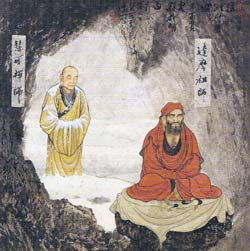
The portrait of the 2nd Chinese Zen
Patriarch Huike stands in the snow
behind Bodhidharma in the cave at
Shaolin Temple, Henan, China, c. 530 CE
Huike cuts off his arm
In one legend, Bodhidharma refused to resume teaching until his would-be student, Dazu Huike, who had kept vigil for weeks in the deep snow outside of the monastery, cut off his own left arm to demonstrate sincerity.
Bodhidharma at Shaolin
Some Chinese accounts describe Bodhidharma as being disturbed by the poor physical shape of the Shaolin monks, after which he instructed them in techniques to maintain their physical condition as well as teaching meditation. He is said to have taught a series of external exercises called the Eighteen Arhat Hands (Shi-ba Lohan Shou), and an internal practice called the Sinew Metamorphosis Classic. In addition, after his departure from the temple, two manuscripts by Bodhidharma were said to be discovered inside the temple: the Yijin Jing (易筋經 or “Muscle/Tendon Change Classic”) and the Xi Sui Jing. Copies and translations of the Yi Jin Jing survive to the modern day. The Xi Sui Jing has been lost.
Travels of Bodhidharma
According to Southeast Asian folklore, Bodhidharma travelled from south India by sea to Sumatra, Indonesia for the purpose of spreading the Mahayana doctrine. From Palembang, he went north into what are now Malaysia and Thailand. He travelled the region transmitting his knowledge of Buddhism and martial arts before eventually entering China through Vietnam. Malay legend holds that Bodhidharma introduced preset forms to silat.
Appearance after his death
Three years after Bodhidharma’s death, Ambassador Song Yun of northern Wei is said to have seen him walking while holding a shoe at the Pamir Heights. Song Yun asked Bodhidharma where he was going, to which Bodhidharma replied “I am going home”. When asked why he was holding his shoe, Bodhidharma answered “You will know when you reach Shaolin monastery. Don’t mention that you saw me or you will meet with disaster”. After arriving at the palace, Song Yun told the emperor that he met Bodhidharma on the way. The emperor said Bodhidharma was already dead and buried, and had Song Yun arrested for lying. At the Shaolin Temple, the monks informed them that Bodhidharma was dead and had been buried in a hill behind the temple. The grave was exhumed and was found to contain a single shoe. The monks then said “Master has gone back home” and prostrated three times.
[pull_quote_center]For nine years he had remained and nobody knew him;
Carrying a shoe in hand he went home quietly, without ceremony.[/pull_quote_center]
Modern scholarship
Biography as a hagiographic process
[quote_box_center]”It is ultimately impossible to reconstruct any original or accurate biography of the man whose life serves as the original trace of his hagiography – where “trace” is a term from Jacques Derrida meaning the beginningless beginning of a phenomenon, the imagined but always intellectually unattainable origin. Hence any such attempt by modern biographers to reconstruct a definitive account of Bodhidharma’s life is both doomed to failure and potentially no different in intent from the hagiographical efforts of premodern writers”[/quote_box_center]
McRae’s standpoint accords with Yanagida’s standpoint:
[quote_box_center]”Yanagida ascribes great historical value to the witness of the disciple T’an-lin, but at the same time acknowledges the presence of “many puzzles in the biography of Bodhidharma”. Given the present state of the sources, he considers it impossible to compile a reliable account of Bodhidharma’s life”.[/quote_box_center]
Several scholars have suggested that the composed image of Bodhidharma depended on the combination of supposed historical information on various historical figures over several centuries. Bodhidharma as a historical person may even never have actually existed.
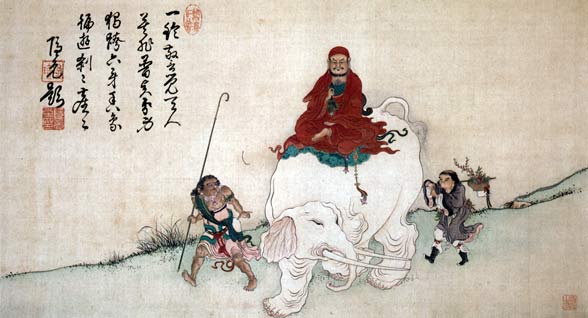
Bodhidharma on Elephant Yiran Inscription by Yinyuan color on silk hanging scroll
Origins and place of birth
Dumoulin comments on the three principal sources. The Persian heritage is doubtful, according to Dumoulin:
[quote_box_center]”In the description of the Lo-yang temple, bodhidharma is called a Persian. Given the ambiguityof geographical references in writings of this period, such a statement should not be taken too seriously”.[/quote_box_center]
Dumoulin considers Tan-lin’s account of Bodhidharma being “the third son of a great Brahman king” to be a later addition, and finds the exact meaning of “South Indian Brahman stock” unclear:
[quote_box_center]”And when Tao-hsuan speaks of origins from South Indian Brahman stock, it is not clear whether he is referring to roots in nobility or to India in general as the land of the Brahmans”[/quote_box_center]
These Chinese sources lend themselves to make inferences about Bodhidharma’s origins. “The third son of a Brahman king” has been speculated to mean “the third son of a Pallavine king”. Based on a specific pronunciation of the Chinese characters 香至 as Kang-zhi, “meaning fragrance extreme”, Tstuomu Kambe identifies 香至 to be Kanchipuram, an old capital town in the state Tamil-Nadu. According to Tstuomu Kambe:
[quote_box_center]”Kanchi means ‘a radiant jewel’ or ‘a luxury belt with jewels’, and puram means a town or a state in the sense of earlier times. Thus, it is understood that the ‘香至-Kingdom’ corresponds to the old capital ‘Kanchipuram’.”[/quote_box_center]
Indian caste system
In the context of the Indian caste system the mention of “Brahman king” acquires a nuance. Broughton notes that “king” implies that Bodhidharma was of a member of the Kshatriya caste of warriors and rulers. Brahman is, in western contexts, easily understood as Brahmana or Brahmin, which means priest.
Bodhidharma’s name
According to tradition Bodhidharma was given this name by his teacher known variously as Panyatara, Prajnatara, or Prajñādhara.
Bodhidharma is associated with several other names, and is also known by the name Bodhitara. Faure notes that:
[quote_box_center]”Bodhidharma’s name appears sometimes truncated as Bodhi, or more often as Dharma (Ta-mo). In the first case, it may be confused with another of his rivals, Bodhiruci.”[/quote_box_center]
Tibetan sources give his name as “Bodhidharmottāra” or “Dharmottara”, that is, “Highest teaching (dharma) of enlightenment”.
Bodhidharma’s abode in China
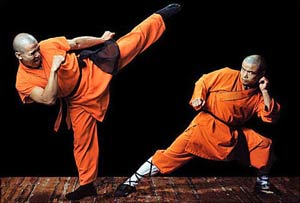
Bodhidharma began the physical training of the
Shaolin monks that led to the creation of
Shaolin Kung Fu
Traditionally Bodhidharma is being credited to be the founder of the martial arts at the Shaolin Temple. However, martial arts historians have shown this legend stems from a 17th century qigong manual known as the Yijin Jing.
Buswell dates Bodhidharma abode in China approximately at the early 5th century. Broughton dates Bodhidharma’s presence in Luoyang to between 516 and 526, when the temple referred to—Yǒngníngsì (永寧寺), was at the height of its glory. Starting in 526, Yǒngníngsì suffered damage from a series of events, ultimately leading to its destruction in 534.
Martial arts
The authenticity of the Yi Jin Jing has been discredited by some historians including Tang Hao, Xu Zhen and Matsuda Ryuchi. This argument is summarized by modern historian Lin Boyuan in his Zhongguo wushu shi:
[quote_box_center]As for the “Yi Jin Jing” (Muscle Change Classic), a spurious text attributed to Bodhidharma and included in the legend of his transmitting martial arts at the temple, it was written in the Ming dynasty, in 1624, by the Daoist priest Zining of Mt. Tiantai, and falsely attributed to Bodhidharma. Forged prefaces, attributed to the Tang general Li Jing and the Southern Song general Niu Gao were written. They say that, after Bodhidharma faced the wall for nine years at Shaolin temple, he left behind an iron chest; when the monks opened this chest they found the two books “Xi Sui Jing” (Marrow Washing Classic) and “Yi Jin Jing” within. The first book was taken by his disciple Huike, and disappeared; as for the second, “the monks selfishly coveted it, practicing the skills therein, falling into heterodox ways, and losing the correct purpose of cultivating the Real. The Shaolin monks have made some fame for themselves through their fighting skill; this is all due to having obtained this manuscript.” Based on this, Bodhidharma was claimed to be the ancestor of Shaolin martial arts. This manuscript is full of errors, absurdities and fantastic claims; it cannot be taken as a legitimate source.[/quote_box_center]
The oldest available copy was published in 1827 and the composition of the text itself has been dated to 1624. Even then, the association of Bodhidharma with martial arts only became widespread as a result of the 1904–1907 serialization of the novel The Travels of Lao Ts’an in Illustrated Fiction Magazine:
[quote_box_center]One of the most recently invented and familiar of the Shaolin historical narratives is a story that claims that the Indian monk Bodhidharma, the supposed founder of Chinese Chan (Zen) Buddhism, introduced boxing into the monastery as a form of exercise around a.d. 525. This story first appeared in a popular novel, The Travels of Lao T’san, published as a series in a literary magazine in 1907. This story was quickly picked up by others and spread rapidly through publication in a popular contemporary boxing manual, Secrets of Shaolin Boxing Methods, and the first Chinese physical culture history published in 1919. As a result, it has enjoyed vast oral circulation and is one of the most “sacred” of the narratives shared within Chinese and Chinese-derived martial arts. That this story is clearly a twentieth-century invention is confirmed by writings going back at least 250 years earlier, which mention both Bodhidharma and martial arts but make no connection between the two.[/quote_box_center]
Practice and teaching
Bodhidharma is traditionally seen as introducing dhyana-practice in China.
Pointing directly to one’s mind
One of the fundamental Chán texts attributed to Bodhidharma is a four-line stanza whose first two verses echo the Laṅkāvatāra Sūtra’s disdain for words and whose second two verses stress the importance of the insight into reality achieved through “self-realization”:
[quote_box_center]”A special transmission outside the scriptures,
Not founded upon words and letters;
By pointing directly to [one’s] mind
It lets one see into [one’s own true] nature and [thus] attain Buddhahood.”[/quote_box_center]
The stanza, in fact, is not Bodhidharma’s, but rather dates to the year 1108.
Wall-gazing
Tanlin, in the preface to Two Entrances and Four Acts, and Daoxuan, in the Further Biographies of Eminent Monks, mention a practice of Bodhidharma’s termed “wall-gazing” (壁觀 bìguān). Both Tanlin and Daoxuan associate this “wall-gazing” with “quieting [the] mind” (安心 ān xīn).
In the Two Entrances and Four Acts, traditionally attributed to Bodhidharma, the term “wall-gazing” is given as follows:
[quote_box_center]”Those who turn from delusion back to reality, who meditate on walls, the absence of self and other, the oneness of mortal and sage, and who remain unmoved even by scriptures are in complete and unspoken agreement with reason”.[/quote_box_center]
Daoxuan states: “The merits of Mahāyāna wall-gazing are the highest”.
These are the first mentions in the historical record of what may be a type of meditation being ascribed to Bodhidharma.
Exactly what sort of practice Bodhidharma’s “wall-gazing” was remains uncertain. Nearly all accounts have treated it either as an undefined variety of meditation, as Daoxuan and Dumoulin, or as a variety of seated meditation akin to the zazen (坐禪; Chinese: zuòchán) that later became a defining characteristic of Chán. The latter interpretation is particularly common among those working from a Ch’an standpoint.
There have also, however, been interpretations of “wall-gazing” as a non-meditative phenomenon.
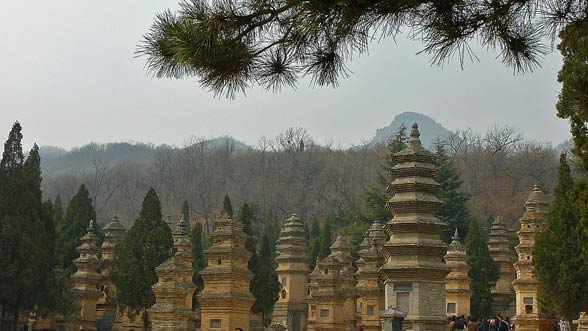
Pagoda Forest at Shaolin Temple, Henan Province, China
The Laṅkāvatāra Sūtra
There are early texts which explicitly associate Bodhidharma with the Laṅkāvatāra Sūtra. Daoxuan, for example, in a late recension of his biography of Bodhidharma’s successor Huike, has the sūtra as a basic and important element of the teachings passed down by Bodhidharma:
[quote_box_center]In the beginning Dhyana Master Bodhidharma took the four-roll Laṅkā Sūtra, handed it over to Huike, and said: “When I examine the land of China, it is clear that there is only this sutra. If you rely on it to practice, you will be able to cross over the world.”[/quote_box_center]
Another early text, the Record of the Masters and Disciples of the Laṅkāvatāra Sūtra (楞伽師資記 Léngqié shīzī jì) of Jìngjué (淨覺; 683–750), also mentions Bodhidharma in relation to this text. Jingjue’s account also makes explicit mention of “sitting meditation”, or zazen:
[quote_box_center]”For all those who sat in meditation, Master Bodhi[dharma] also offered expositions of the main portions of the Laṅkāvatāra Sūtra, which are collected in a volume of twelve or thirteen pages, […] bearing the title of Teaching of [Bodhi-]Dharma”.[/quote_box_center]
In other early texts, the school that would later become known as C’an is sometimes referred to as the “Laṅkāvatāra school” (楞伽宗 Léngqié zōng).
The Laṅkāvatāra Sūtra, one of the Mahāyāna Buddhist sūtras, is a highly “difficult and obscure” text whose basic thrust is to emphasize “the inner enlightenment that does away with all duality and is raised above all distinctions”. It is among the first and most important texts in the Yogācāra, or “Consciousness-only”, school of Mahāyāna Buddhism.
One of the recurrent emphases in the Laṅkāvatāra Sūtra is a lack of reliance on words to effectively express reality:
[quote_box_center]If, Mahamati, you say that because of the reality of words the objects are, this talk lacks in sense. Words are not known in all the Buddha-lands; words, Mahamati, are an artificial creation. In some Buddha-lands ideas are indicated by looking steadily, in others by gestures, in still others by a frown, by the movement of the eyes, by laughing, by yawning, or by the clearing of the throat, or by recollection, or by trembling.[/quote_box_center]
In contrast to the ineffectiveness of words, the sūtra instead stresses the importance of the “self-realization” that is “attained by noble wisdom” and occurs “when one has an insight into reality as it is”: “The truth is the state of self-realization and is beyond categories of discrimination”. The sūtra goes on to outline the ultimate effects of an experience of self-realization:
[quote_box_center][The Bodhisattva] will become thoroughly conversant with the noble truth of self-realization, will become a perfect master of his own mind, will conduct himself without effort, will be like a gem reflecting a variety of colours, will be able to assume the body of transformation, will be able to enter into the subtle minds of all beings, and, because of his firm belief in the truth of Mind-only, will, by gradually ascending the stages, become established in Buddhahood.[/quote_box_center]
Students
In the Two Entrances and Four Acts and the Continued Biographies of Eminent Monks, Daoyu and Huike are the only explicitly identified disciples of Bodhidharma. The Jǐngdé Records of the Transmission of the Lamp (Jǐngdé chuándēng lù 景德传灯录) of Dàoyuán 道原, presented to the emperor in 1004, gives Bodhidharma four disciples who, in increasing order of understanding, are Dàofū 道怤, who attains Bodhidharma’s skin; the nun Dharani, who attains Bodhidharma’s flesh; Dàoyù 道育, who attains Bodhidharma’s bone; and Huìkě 慧可, who attains Bodhidharma’s marrow.
Heng-Ching Shih states that according to the Jǐngdé chuándēng lù 景德传灯录 the first `bhikṣuni` mentioned in the Chán literature was a disciple of the First Patriarch of Chinese Chán Bodhidharma, known as Zōngzhǐ 宗旨 [early-mid 6th century]; Bodhidharma before returning to India after many years of teaching in China asked his disciples Dàofū, Bhikṣuni Zōngzhǐ, Dàoyù and Huìkě to relate their realization of the Dharma. Zōngzhǐ is also known by her title Soji, and by Myoren, her nun name. In the Shōbōgenzō 正法眼蔵 chapter called Katto (“Twining Vines”) by Dōgen Zenji 道元禅師 (1200–1253), she is named as one of Bodhidharma’s four Dharma heirs. Although the First Patriarch’s line continued through another of the four, Dogen emphasizes that each of them had a complete understanding of the teaching.
Lineage
D.T. Suzuki contends that Ch’an’s growth in popularity during the 7th and 8th centuries attracted criticism that it had “no authorized records of its direct transmission from the founder of Buddhism” and that Ch’an historians made Bodhidharma the 28th patriarch of Buddhism in response to such attacks. In the 6th century biographies of famous monks were collected. From this genre the typical Ch’an-lineage was developed:
[quote_box_center]”These famous biographies were non-sectarian. The Ch’an biographical works, however, aimed to establish Ch’an as a legitimate school of Buddhism traceable to its Indian origins, and at the same time championed a particular form of Ch’an. Historical accuracy was of little concern to the compilers; old legends were repeated, new stories were invented and reiterated until they too became legends”.[/quote_box_center]
Yǒngjiā Xuánjué – Song of Enlightenment
According to the Song of Enlightenment (證道歌 Zhèngdào gē) by Yǒngjiā Xuánjué (665-713)[76]—one of the chief disciples of Huìnéng, sixth Patriarch of Chán—Bodhidharma was the 28th Patriarch of Buddhism in a line of descent from Śākyamuni Buddha via his disciple
[quote_box_center]Mahākāśyapa, and the first Patriarch of Chán:
Mahakashyapa was the first, leading the line of transmission;
Twenty-eight Fathers followed him in the West;
The Lamp was then brought over the sea to this country;
And Bodhidharma became the First Father here
His mantle, as we all know, passed over six Fathers,
And by them many minds came to see the Light.[/quote_box_center]
The idea of a line of descent from Śākyamuni Buddha is the basis for the distinctive lineage tradition of the Chán school.
[/vc_column_text][/vc_column][vc_column width=”1/3″][vc_widget_sidebar sidebar_id=”td-default”][/vc_column][/vc_row][vc_row][vc_column][vc_column_text]
[/vc_column_text][/vc_column][/vc_row]
